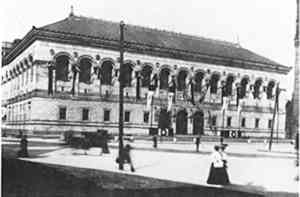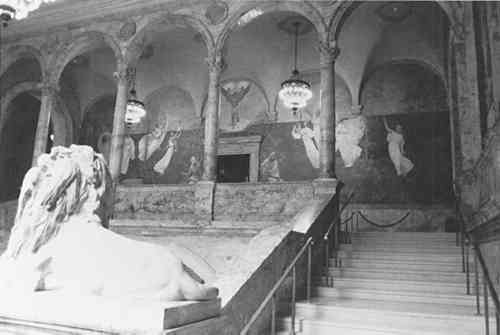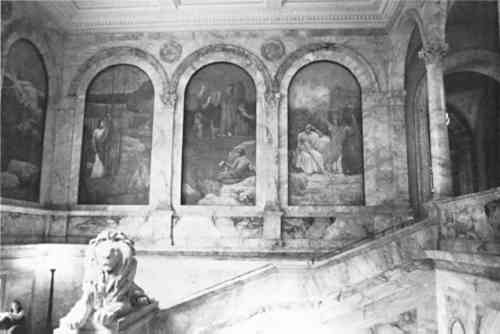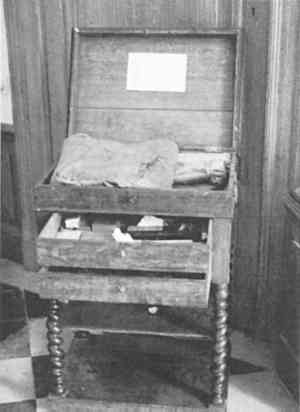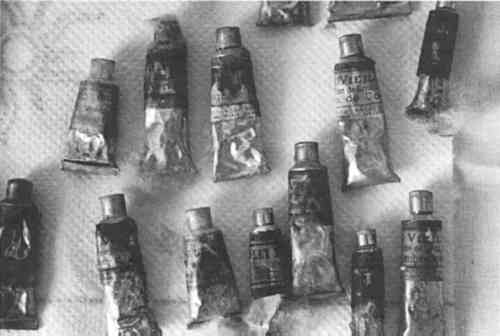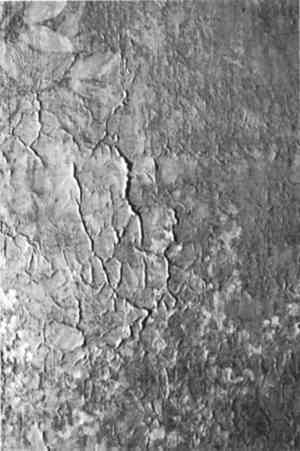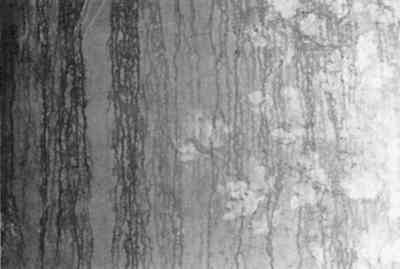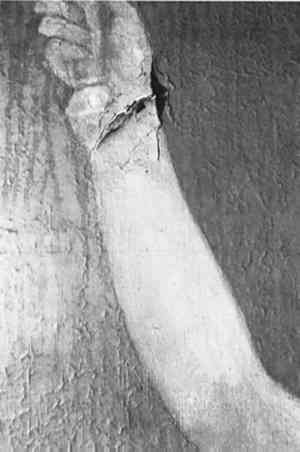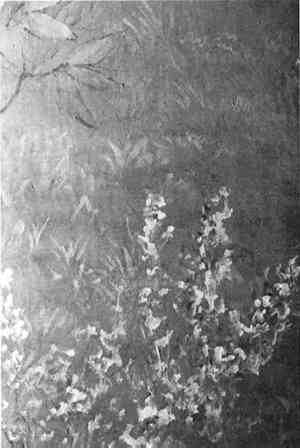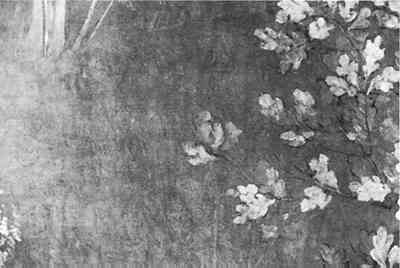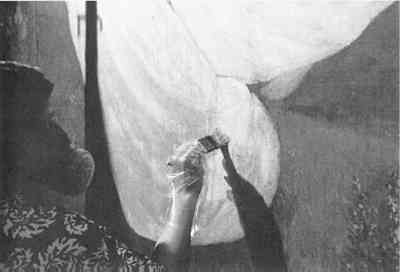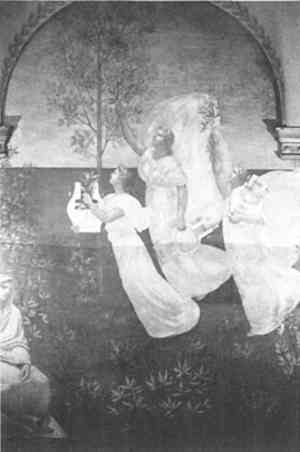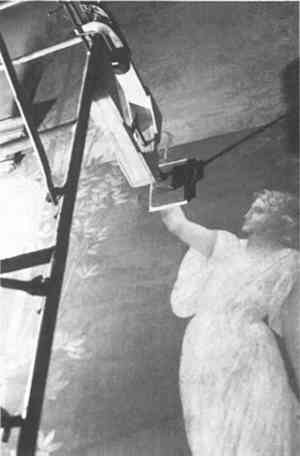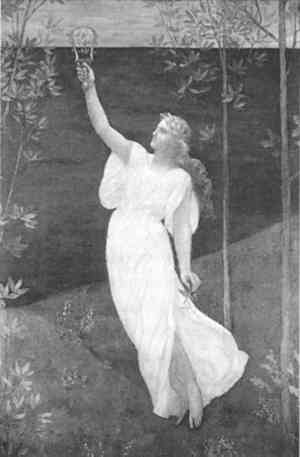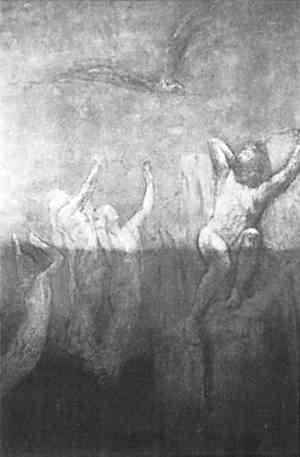PUVIS DE CHAVANNES'S ALLEGORICAL MURALS IN THE BOSTON PUBLIC LIBRARY: HISTORY, TECHNIQUE, AND CONSERVATIONTERI HENSICK, KATE OLIVIER, & GIANFRANCO POCOBENE
ABSTRACT—Puvis de Chavannes's allegorical murals, installed in the Boston Public Library between 1895 and 1896, were recently conserved by the staff of the Straus Center for Conservation as part of an ongoing major renovation of the building. The treatment of the murals included the consolidation of large areas of flaking paint, the reattachment of detached canvas sections, and the removal of tenacious surface grime. The opportunity to examine and analyze the Boston murals and to study archival material in France, as well as other murals there, has yielded interesting information about the materials and techniques Puvis used to create his highly individual and influential murals. The authors combine information about the Boston Public Library commission with the methods and materials used in the murals, the conservation treatment, and additional materials analysis. TITRE—Les peintures murales all�goriques de Puvis de Chavanne � la biblioth�que municipale de Boston: Histoire, technique et restauration. R�SUM�—Les peintures murales all�goriques de Puvis de Chavanne, intall�es dans la biblioth�que municipale de Boston entre 1895 et 1896, furent r�cemment restaur�es par le personnel du Straus Center for Conservation. Le traitement de ces peintures murales s'inscrit dans le cadre d'une r�novation g�n�rale du b�timent, toujours en cours, et comprend la consolidation de zones importantes de soul�vements, la remise en place des sections o� la toile s'�tait d�tach�e et le nettoyage de la surface couverte d'une salet� tenace. L'examen et l'analyse de ces peintures murales, ainsi que l'�tude de documents d'archives et de certaines autres peintures murales conserv�es en France, ont permis la mise � jour de renseignements int�ressants concernant les techniques utilis�es par Puvis pour cr�er ses peintures murales, si originales et si influentes. Les auteurs pr�sentent des informations sur la commande de la biblioth�que municipale de Boston, les m�thodes de travail et les mat�riaux employ�s dans les peintures murales, la restauration de ces peintures et les r�sultats de l'analyse d'autres mat�riaux. TITULO—Los murales aleg�ricos de Puvis de Chavannes de la Biblioteca Publica de Boston: historia, t�cnica y conservaci�n. RESUMEN—Los murales aleg�ricos de Puvis de Chavannes que fueron montados en la Biblioteca Publica de Boston entre los a�os 1895 y 1896, fueron recientemente conservados por el equipo del Centro Straus para la Conservaci�n, como parte de la gran remodelaci�n que se esta llevando a cabo en el edificio. El tratamiento de los murales incluyo la consolidaci�n de grandes �reas de pintura que se habia escamado, la uni�n de secciones de lienzo desprendidas y la remoci�n de tenaz suciedad superficial. La oportunidad de examinar y analizar los murales de Boston, y de estudiar documentos pertinentes ubicados en archivos franceses, tanto como otros murales en Francia, produjo interesante informaci�n acerca de los materiales y las t�cnicas utilizadas por Puvis en la creaci�n de estos murales muy particulares y trascendentales. Los autores combinaron informaci�n sobre la Comisi�n de la Biblioteca Publica de Boston con los m�todos y materiales utilizados en los murales, el tratamiento de conservaci�n y el an�lisis adicional de materiales. 1 INTRODUCTIONThe Boston Public Library (fig. 1) is one of the great Renaissance Revival buildings of America. Designed and built between 1888 and 1895 by
Pierre Puvis de Chavannes (1824–98), widely considered the greatest European muralist of the time, was the ideal candidate to decorate the grandest and most complicated space in the new library. By the 1890s he had painted most of his major mural decorations, including projects for the Pantheon and the Sorbonne in Paris, and for museums and municipal buildings in Lyon, Rouen, Amiens, Poitiers, and Marseille. Although in his youth he studied for brief periods in the studios of Eugene Delacroix, Thomas Couture, and Theodore Chasseriau, Puvis's individual style and technique were developed largely independently. Combining idealized classicism with simple flat designs and pale colors, his murals were in great demand. From the beginning, the intention was that the library's imposing grand staircase and loggia be decorated with murals. Thus it was that in 1891 Charles Follen McKim traveled to Paris to engage Puvis's services. Convincing the aged painter to undertake the commission proved no easy task, but McKim was initially successful. Soon after, however, Puvis was awarded a commission for the Paris City Hall and had second thoughts about the American project. Another emissary was sent to Paris in 1892, and as a further inducement the artist was given a plaster scale model of the library's interior. Finally, on July 7, 1893, Puvis signed a contract for the murals that guaranteed him 250,000 francs, the equivalent of the then-unparalleled sum of $50,000. A year later, after completing the Paris City Hall project, the painter began working on the Boston murals and asked for more detailed measurements. He also requested, and was sent, a sample of the marble to be used in the staircase so that he might harmonize his palette with the surrounding architecture. Puvis's oversized murals were executed on canvas in a specially designed studio at Neuilly, which included a two-story door (fig. 2)(Milner 1988). The Inspiring Muses was the first mural to be painted. It was exhibited at the Salon du Champs-de-Mars, then rolled and transported to Boston in October 1895, and finally mounted on the east wall of the loggia a month later (fig. 3). During the following year, the other eight panels were completed, exhibited in Paris, shipped, and installed (fig. 4). In fact, the artist himself never saw his works in situ. Their installation using a marouflage technique was overseen by Puvis's trusted collaborator Victor Koos. The arrival of the murals in Boston was met with much fanfare and celebration. In France, on the other hand, the art critic Gustave Geffroy expressed the feelings of many Frenchmen when he wrote:
So it was that Boston acquired the only murals by Puvis to be found outside of France. 2 NARRATIVE OF THE MURALSThe spaces to be decorated consisted of eight arched spaces above the library's grand staircase and a large, complex-shaped wall in the loggia. Puvis was given complete artistic freedom to create a narrative for the cycle. He described the theme for his mural program as a synthesis of the intellectual holdings contained in the Boston Public Library expressed in a symbolic framework. The mural in the loggia, titled The Inspiring Muses Acclaim Genius, Messenger of Light, is a summation of the entire schema. The Inspiring Muses(fig. 3), the largest of the murals, covers 75.25 sq. m. (660 sq. ft.); it is 4.88 m (16 ft.) high and almost 15.42 m (50 ft. 7 in.) wide. Along the top of the wall, capitals and vault supports project downward, dividing the field into five tympana. At the bottom is a centrally placed door. Puvis expressed concern about the compositional problems caused by this setting and at the possibility of having to paint separate images to fill the space. He made numerous drawings and sketches and finally chose to unify the space with one continuous scene. Above the door, a winged boy representing the Genius of Enlightenment stands on a cloud with blazing lights in his hands against a pale yellow sky that extends across all five arches. Below the sky is an expanse of deep blue water, and below that oak and laurel trees are scattered over a green field dotted with flowering bushes. The nine Muses of Inspiration, representing the various divisions of literature and the arts (Esch 1982), float above the landscape, draped in white and holding lyres and laurel branches. On either side of the door Puvis painted stone statues representing Study and Meditation in grisaille. For the eight paintings in the staircase, each 4.37 m (14 ft. 4 in.) high by 2.18 m (7 ft. 2 in.) wide, Puvis chose subjects that represent the various spheres of human knowledge. On the south wall he painted Philosophy, Astronomy, and 3 MATERIALS AND TECHNIQUEFirsthand accounts of the materials and techniques Puvis used for the murals come primarily from the writings of his students and contemporaries as Puvis himself revealed very little. The observations of conservators and art historians, combined with recent scientific analysis, provide additional information that corroborates much of what was written during Puvis's time. The preparatory studies and sketches Puvis created for the murals were an indispensable part of the final product; indeed, the sketches tell us most about his creative process. Prized in Puvis's day, many of the sketches for the Boston Public Library project were exhibited in the Salon of 1896. Geffroy reported that
Today, sketches for the library murals are preserved in numerous private and public collections. The Cabinet des Dessins at the Louvre houses five related works. Two of the small compositional studies, both about 10 x 33 cm (4 x 13 in.), are in ink over pencil on tracing paper. They reveal that Puvis did not at first conceive of the Muses as figures floating over the landscape but as figures standing firmly on the ground. In a third study at the Louvre (RF23070), Puvis raised the Muses as in the final design. This change was made so that the figures would not be truncated by the solid balustrade when seen from halfway up the staircase (Price 1994, 230). Puvis drew hundreds of life drawings from models in his studio. He used distillations of these sketches, squared up and transferred, for the figures in the murals. A drawing for one of the Boston Public Library Muses (the second figure from the left in The Inspiring Muses) reveals that Puvis carefully worked out the pose of the figure in a nude sketch (Petit Palais, P.P.D 274.1) before draping her in a robe in another sketch of the same size (Lyon Inv. B607–28). Puvis also made numerous small color studies for each mural project. He rendered his color ideas for the library murals in various media. In a study for Physics he painted in gouache on cardboard. Some sketches for the Muses were executed in oil on canvas, others in watercolor. The final step in the preparatory process was the creation of a full-scale painted cartoon combining many of the earlier studies. According to Puvis's student and collaborator Paul Baudouin, the cartoons Puvis produced for his mural projects “were very precise and studied works, in which all of the values were expressed” (Baudouin 1935, 300). Baudouin also noted that Puvis used either paper or canevas (a French word describing a coarse, light-colored cloth used for tapestry making) as a support for his large-scale cartoons. Notations on a photograph taken while the cartoon for the Inspiring Muses was on exhibit in the Salon of 1920, in the files of the Mus�e d'Orsay, indicate that the cartoon was painted in gouache on paper. The present whereabouts of the cartoon are unknown; its last location was in the attic of the Comic Opera, Paris (d'Argencourt et al. 1977, 231). Puvis executed the Boston murals on a plainweave linen canvas, typical of the type he generally chose for his monumental wall decorations. In the library murals the coarseness of the canvas is evident in many thinly or dryly painted passages. Puvis had access to immense canvases. Only two pieces of linen were used for The Inspiring Muses, each one measuring 4.88 m (16 ft.) high with the left half 8.81 m (28 ft. 11 in.) long and the right half 6.60 m (21 ft. 8 in.) long. Due to the light, unsaturated colors and almost matte surfaces of Puvis's murals, many people—beginning with the critic Th�ophile Gautier—have mistakenly referred to them as frescoes (Gautier 1861, 102–6). In fact, he appears to have experimented only once with pigments bound in lime on plaster. These works were painted (ca. 1853–54) at Le Brouchy, his brother's home outside of Lyon. Executed on an exterior wall, the paintings are now badly weathered. Puvis's success in achieving a frescolike appearance for his murals using oils can be explained by the combination of several techniques, starting with his grounds. Each library canvas was primed with a fairly thin ground layer of white chalk in a glue medium (see appendix 1). Various authors have described Puvis's grounds with the French term pl�tre (plaster), which refers generically to any sort of plaster, including lime and, hence, chalk. Grounds composed of chalk and glue have been found on most of Puvis's murals analyzed to date (Galinier 1995). The role of the ground in soaking up excess medium was duly noted in Puvis's time. According to one author, it was this highly absorbent ground “which gives his work that dead surface” (Hamerton, quoted in Crowninshield 1887, 105). Two of Puvis's contemporaries also suggest how he achieved the particularly frescolike appearance in his use of oil paints. According to the painter Frederic Crowninshield (1887), he deadened his oils by adding spirits of turpentine. Paul Baudouin (1935) writes that Puvis drained his oils by placing them on papier buvard (blotting paper). Baudouin also states emphatically that Puvis never added anything to his paints (no siccatives, copal, varnish, or any other ingredient). Each of these techniques, combined with the fond maigre (absorbent ground), would obviously produce a lean, matte paint with little if any excess oil. According to one contemporary observation, Puvis painted in “common oil-paints” (Crowninshield 1887). This fact was confirmed by the discovery of some of Puvis's leftover paint tubes in a paint box preserved by the artist's heirs at Le Brouchy (fig. 5). A list of the various colors found in the paint box is included in table 1. Puvis purchased paint from several different colormen and paint manufacturers in Paris. The tubes are tin with metal screw caps, which would date them after 1865 when screw caps began to replace the corks previously in use (Lefranc and Bourgeois 1990)(fig. 6). A box of six tubes is labeled “Exposition Universelle de 1889 Grand Prix.” Some of the tubes (from Gay and Lefranc) are labeled “ground in oil” while those from Bourgeois Ain�e are a “new preparation for painting in gouache.”
TABLE 1. TUBES OF PAINT FOUND IN PUVIS'S PAINT BOX AT LE BROUCHY Numerous authors have also suggested that Puvis achieved a matte appearance by adding wax to his painting medium. By the late 1840s, the use of wax was commonplace in French mural painting. Delacroix (at St. Sulpice), Hippolyte Flandrin (at St. Germain-des-Pr�s), and Chasseriau (at St. Roch) all painted � la cire(Baudouin 1914). In this technique, wax was either saponified with lime or dissolved in mineral spirits, making it usable without heat (B�guin 1981). According to his student Lasalle-Bordes, Delacroix added small amounts of wax to the oils on his palette as he worked at L'Assembl�e Nationale (S�rullaz 1995). There is no documentary evidence that Puvis mixed wax with his oils in this manner. Indeed, no wax was detected in the two samples from Puvis's Boston murals analyzed with gas chromatography (see appendix 1). Furthermore, solubility problems Puvis may or may not have been aware of the wax component in the tubes of paint he purchased. One of the samples that contained wax is from a tube labeled “ground in oils” and gives no indication of any wax additive. Carpentier (1875), among others, warned against mixing wax and oil because the wax stops the oil from drying and the oil stops the wax from hardening. By 1897, Lefranc advertised an oil paint that was “completely solid” containing “not an atom of wax” (Lefranc and Cie 1897). We can assume, therefore, that by the end of the 19th century, fewer and fewer color manufacturers added wax to their oils. To imitate the pale colors of fresco in his Puvis applied paint in a direct manner, often using just one or two layers. No glazes were observed in the murals, and only one of the numerous cross sections taken revealed a third layer. He textured his paint by various means: thick, dry impastos; thin, lean layers revealing the coarse texture of the canvas; passages of thick paint scraped flat; and incisions and scratches inscribed with various pointed tools or spatulas. Puvis also left some areas of canvas uncovered, especially outlining figures and trees, which often reveal what appears to be a charcoal underdrawing. The very few pentimenti visible in the Boston murals may well be explained by his thorough preparation or by his practice of scraping off unwanted passages rather than painting over them. Puvis recommended this practice to his followers: “Be fearful of useless impastos which darken, turn bluish and heavy. When you have painted a passage that you dislike, wait until it is possible to remove it. Judge it and if it is condemned, scrape it off firmly with a palette knife…. Excess paint is an abomination. In twenty four hours the gold will change to lead” (quoted in Vachon 1895, 57). It is highly unlikely that Puvis applied a varnish to his mural works. Ultraviolet light examination of his first mural cycle located at Le Brouchy has revealed that as early as the 1850s, Puvis chose not to apply a final varnish coating. The recent treatment and analysis of the Boston murals detected no original resin coating. As with many other questions of technique, Puvis appears to have written nothing at all about varnishing his paintings. His student Baudouin, who notes that Puvis never added varnish to his paint mixtures, also makes no mention of varnishing and adds that Puvis's Childhood of St. Genevieve (1876) in the Pantheon “gives the total illusion of frescoes” (Baudouin 1935, 300). The use of all these techniques produced the frescolike appearance so sought after by Puvis. He firmly believed that murals should not dominate an architectural space. To that end, he created paintings with minimal illusionistic depth by using light colors with unsaturated and unvarnished surfaces. Puvis chose colors that would harmonize with the library's marble staircase, and he flattened the figures and other elements to emphasize the two-dimensional nature of the wall. In Boston, as in France, Puvis's gigantic canvases were mounted to the wall using marouflage. The technique of affixing oil paintings on canvas to a wall or ceiling originated in 17th-century France (Mora et al. 1984). Thus the artist could work in the comfort and privacy of his studio, surrounded by his own paraphernalia. When the painting was finished it was usually rolled and delivered to the site for installation by a mural hanger. In French, maroufle refers to the sticky remnants of paint left in an artist's pots. The adhesive typically consisted of oils, resins, and fillers mixed into a thick paste. By the beginning of the 19th century, c�ruse (lead carbonate) was added to speed up the drying process (Mora et al. 1984, 157). For Puvis's murals at the library, lead white was a major component in the mounting adhesive. Although Puvis was not involved in the Boston installation, he did personally supervise the marouflaging of many of his murals in France. Paintings marouflaged with lead white paste are extremely durable and often show no signs of cracking. Puvis's murals in Amiens and in the Boston 4 CONSERVATIONDocumentary evidence indicates that Puvis's murals were restored on at least three previous occasions. The first documented treatment occurred in 1930 when they were cleaned and coated by Charles Durham. Commenting on that early restoration, Edward Forbes wrote that “the protective surface that was put on … was a mixture of the white of egg combined with some other ingredients, which makes a sort of varnish and has given the paintings a slight gloss” (Forbes 1940). In 1940, the restorer R. Arcadius Lyon cleaned the murals with a weak solution of castile soap (sodium carbonate and olive oil) and water. At that time he found that the previously applied egg white coating was tough and well adhered and that it did not respond well to his cleaning efforts. Fearing possible damage to the paint layers, he chose not to try stronger cleaning solutions and decided to leave the coating on the surface (Forbes 1940). Finally, Finlayson Brothers restored the murals in 1953, but they do not appear to have left any documentation of the treatment. As part of a major restoration program for the library, the murals were scheduled for conservation in 1994. They were generally in a very good state of preservation but did require surface cleaning, consolidation of minor flaking, and retouching of minor abrasions. During the early phase of the renovation, however, an unfortunate event necessitated the immediate conservation treatment of The Inspiring Muses. In the early morning hours of February 3, 1992, the painting was badly damaged by water condensing on its surface as a result of an accidental steam valve release. Fortunately, the other eight murals on the staircase were not damaged, as they had been covered with multilayer barriers to protect them from the renovation work. Kate Olivier, who was the first conservator from the Straus Center for Conservation to arrive at the scene, found the area still full of hot, white steam and described it as “like being in a Turkish bath.” The first RH reading, taken that morning shortly after 9:00 a.m. was 87%, but it surely must have been very near 100% earlier that morning. Fans were installed in the staircase windows to extract the damp air. By midafternoon the RH had dropped to 77%, and by the next morning it had dropped to 55%. Later, a protective polyethylene barrier was draped around the scaffolding in front of the mural, and humidifiers were placed in the enclosure to control the humidity level. The steam caused three specific types of damage. The most serious was extensive lifting and tenting of the paint layers that affected approximately 40% of the painting (fig. 7). Most of the damage occurred on the right half of the mural; fewer and smaller sections were affected on the left half. Why this occurred is not entirely clear, but a likely explanation is that variations in air currents increased the amount of water condensation on the right. Fortunately, the canvas did not shrink very much because of its strong attachment to the wall. The areas of lifting varied in severity over the surface of the painting. The worst damage occurred along the bottom
Given the urgency of the situation, consolidation tests were begun immediately. Access to the entire surface of the mural was provided by the fixed scaffolding that had been installed for other renovation activities. Of the many adhesives considered, the two adhesives finally selected for testing on the mural were sturgeon glue and BEVA 371. Both were effective in readhering the paint layers. The BEVA 371, however, held the flaking paint more effectively during the removal of the excess adhesive. In addition, it would not be affected by water-based cleaning solutions that would later be required to remove the surface grime and stains; it would not cause further canvas shrinkage during application; and it would be less affected by fluctuations in temperature and relative humidity. The BEVA 371 adhesive, diluted (1:1) in benzine
After the consolidation was complete, the fixed staging was replaced in favor of rolling scaffolding, which allowed more flexibility and
A number of conservators and conservation scientists have expressed concerns about the use of some of Wolbers's cleaning solutions. They question the solubility effects of various components on the paint layers, the difficulties of clearing surface residues, and the long-term effects of residues that might remain on the paint layers. These issues led to repeated, painstaking rinsing of the mural surface. Given its size and the quantities of cleaning solution used, it is still possible that some residues remain. However, no other cleaning solution was found to remove the accumulated grime and staining. In the white drapery of the Muses the redeposited accretions and streaks were also removed, but it became evident after cleaning that the paint layers had been darkened slightly by the condensing steam. While the nature of this darkening effect was not determined, possible causes include: (1) the conversion of lead The detached canvas areas were plasticized by the application of local moisture and pressure. To apply the necessary pressure, a jig made from a veneer press was secured to the scaffolding using C-clamps (fig. 14). Dampened blotters, sections of foam (to allow the blotter to conform to the distortion), and a Masonite board were placed against the delaminated canvas, and gentle pressure was exerted. After some 40 minutes the paint and canvas were sufficiently plasticized, and the dampened blotters and foam were removed. They were replaced with dry blotters, a 1/4 in. thick Ethafoam section, and a Masonite board and left in place overnight to allow the canvas to dry flat. The detached canvas was then readhered to the wall with Jade 403 (polyvinyl acetate emulsion), and the adhesive was allowed to set under the pressure of Mylar, blotters, and Masonite board for 24 hours. Although Jade 403 is basically an irreversible adhesive, it is sufficiently weaker than the lead white paste and was chosen for its strength and flexibility.
In comparison to the scale of the mural, the losses were small and relatively few. Filling of the losses was not necessary since they occurred in the thinnest paint layers and thus would not be noticeable from a normal viewing distance. The losses and irreversible remnants of the drip marks were inpainted with Bocour Magna Colors (fig. 15). These paints were chosen for their reversibility and appropriate degree of opacity to match the original colors. Although the colors have been discontinued, the Straus Center for Conservation still has a full complement. Retouchings that dried too matte were glazed and adjusted with Acryloid B-72 in xylenes.
Once conservation of The Inspiring Muses was completed, treatment proceeded on the other eight murals in the staircase. Apart from Philosophy, which has had a history of structural problems, these murals were in good condition and required very little consolidation. Surface grime was thick throughout, but especially obscuring
Although the Boston murals were not originally varnished, consideration was given to the possibility of applying a protective coating. Issues of public accessibility, vandalism (thus far not a problem), and the redeposition of grime were the main concerns. Natural resins and most synthetics were considered but rejected because of their high saturating properties and poor aging characteristics. Acryloid B-72 was chosen for testing because of its stability and lower saturating properties. It was applied by brush in concentrations ranging from 2 to 6% in xylenes. It was clear to conservators and art historians who were consulted that varnishing would impart far too much saturation and gloss to be aesthetically acceptable. Another concern was the solubility effect that aromatic hydrocarbon solvents would have on the BEVA 371 that was used to consolidate the paint layers should it become necessary to remove the varnish in future treatments. Furthermore, Puvis's clear desire for a matte surface dictated that the murals should remain unvarnished. After the grand staircase was reopened to the public, low display cases were placed against the dado below The Inspiring Muses to create a partial barrier between the mural and visitors to the library. 5 CONCLUSIONSThe conservation decisions that were reached were based on the scale and urgency of the problems faced. Using the citrate and detergent gel solution proved to be the safest and most effective way of removing the surface grime and the worst effects of the stains and drip marks. Although concerns about the effect of this solution on paint layers should not be ignored, in this instance its positive attributes were decisive. An important factor was that it caused no blanching, thus eliminating the need for varnish. Puvis's skillful and remarkable integration of a mural cycle into a complex space for a building he never saw is a testament to his unusual abilities. While it is recognized that Puvis's images had a significant influence on 20th-century painting, the impact of his highly individual painting technique has not been adequately acknowledged. Painting in oils on canvas, he combined various methods and materials to imitate the matte appearance of frescoes. He used coarse canvases, absorbent grounds, drained oils, pigments mixed with large amounts of white, and a variety of texturing techniques. Contrary to common practice in the first half of 19th-century France, he did not add varnish and other ingredients to his medium, nor did he apply a final varnish coating to his murals. His role in the introduction of these innovative techniques, which became common practice in this century, warrants further investigation. ACKNOWLEDGEMENTSACKNOWLEDGMENTS The authors are greatly indebted to Richard Newman, who analyzed the binding media and compiled appendix 1, and to Richard Wolbers, who produced appendix 3 and without whose research the treatment of the murals would not have been so successful. We are also extremely grateful to David Bomford, Yvonne Hoppenot, Hayden Maginnis, Anne Roquebert, Hubert de Truchis de Lays, Amy Snodgrass, and especially Aim�e Brown Price for their invaluable support and assistance. For their tireless work, enthusiasm, and efficiency we would like to thank our conservation colleagues Nancy Buschini, Lenora Rosenfield, Danica Stojkovikova, Lydia Vagts, Nancy Garrison, and particularly Catherine Rogers, who was indispensable throughout the entire project. Finally, we would like to acknowledge the support of the Boston Public Library and the architectural firm Shepley, Bulfinch, Richardson, and Abbott, and to thank the National Endowment for the Arts for funding the professional development grant. Photographs are reproduced courtesy of the APPENDIX1 APPENDIX 11.1 BINDING MEDIA OF THE MURALS1.1.1 GroundA sample of the ground was hydrolyzed, derivatized with phenylisothiocyanate, and analyzed for amino acids by high-performance liquid chromatography (HPLC) following Waters Chromatography “Pico Tag” method. Analyses were carried out on a Waters instrument that consisted of two 510 pumps, a manual injector, and 991M photo diode array detector. The amino pattern closely matched that of collagen, with the exception of considerably reduced glutamic and aspartic acid levels; these amino acids are typically lost during sample preparation when calcium carbonate is present, as was the case in the ground sample (Halpine 1992). Another portion of the ground was saponified in 10% KOH in methanol, the solution neutralized and then extracted twice with ether. Ether extracts were combined, evaporated to dryness, redissolved in a small amount of methylene chloride, and methylated with 10 μl dimethylformamide dimethyl acetal (Pierce Chemical Co.). Analysis was carried out by gas chromatography—mass spectrometry (GC-MS) on a Hewlett Packard 5890 capillary gas chromatograph equipped with an HP 5971A mass selective detector. The sample was found to contain traces of palmitic and stearic acids, which are typical contaminants in animal glues. It is also possible that these fatty acids came from the overlying oil paint layer. 1.1.2 Paint BinderTwo samples were saponified and analyzed by GC-MS as described above. While traces of hydrocarbons were detected, such as those characteristic of hydrocarbon waxes such as ceresin, the very low levels suggest that they may simply be contaminants in the oil and not indicative of wax intentionally added by the paint manufacturer. Traces of methyl dehydroabietate, an oxidation product commonly found in aged pine resins, were also detected in the two samples. The level was extremely low, so it cannot be concluded that pine resin was an intentional component of the paint. Ratios of the C9 and C8 dicarboxylic acids (diC9/C8) suggest that the oil was not heat-bodied. The palmitic/stearic acid ratios (P/S) are somewhat high for linseed oil; possibly the oil was walnut or a mixture of linseed and poppyseed. Poppyseed was identified in all four samples from the tubes of paint (see next section).
1.1.3 Tube PaintsFour partially dried samples from tubes preserved from Puvis's studio by his heirs were analyzed by GC-MS as described above. The oil in each appears to be poppyseed, based on the high palmitic/stearic acid ratios (P/S). Two samples contained substantial amounts of straight-chain hydrocarbons in the C22-C32 range, maximizing at C26. This hydrocarbon pattern is typical of ceresin wax. The results were as follows (when two analyses were carried out, P/S ratios from both are given): 2 APPENDIX 22.1 ANALYSIS OF THE PIGMENTS, MAROUFLAGE ADHESIVE, AND STAINS2.1.1 PigmentsNine paint samples were selected for analysis, including two greens, one red, four blues, and two whites. Cross sections of the paint samples were examined using a Leitz Laborlux biological microscope fitted with visible and ultraviolet light sources. The cross sections were prepared by imbedding the paint samples in cubes of bioplastic polyester resin, which were subsequently cut and polished with micromesh polishing cloths to reveal the structure of the paint layers. The cross sections were analyzed for their elemental composition using a JEOL 6400 scanning electron microscope with a Noran Instruments Z Max 30 Series light x-ray energy dispersive x-ray spectrometer (SEM-EDX). Sample sites were analyzed for 100 counts at an accelerating voltage of 20 kilo electron volts (keV). Standardless quantitative analysis was performed by the calibrated voyager quantitative microanalysis system using ZAF matrix corrections. Fourier transform infrared microspectroscopy (FTIR) was performed using a Spectra-Tech IR-Plan microscope attached to a Nicolet 510M spectrometer with an auxiliary MCT detector. Samples were mounted for analysis on a Spectra-Tech Micro Sample Plan fitted with a diamond window, and data were collected for 200 scans at a spectral resolution of 8 cm−1. The resulting spectra were viewed in absorbance mode between 625 and 4000 wave numbers, and for consistency the CO2 peak was removed and the spectra were baseline corrected. Pigments were identified by microscopy and SEM-EDX (see table). Analyses showed that lead white was used throughout the painting as highlights and aa matrix for the colors. For example, the highlight from The Inspiring Muses is lead white over a gray layer composed of lead white modified with ultramarine, red oxide, emerald green, and carbon black. The principal green pigments used were emerald green (copper aceto-arsenite) and green earth (hydrous iron, magnesium, and aluminum potassium silicate). Emerald green was found in the grass of Philosophy and in the initial green layer of the foreground of the Muses, together with green earth. The upper layer of the foreground of the Muses contains particles of green earth in a lead white matrix. The principal blues found were cobalt blue (cobalt aluminate) and synthetic ultramarine (sodium aluminum silicate). The water for the Muses was ultramarine mixed with lead white, black, and red in one simple layer. The blue sky in both Chemistry and Aeschylus is cobalt blue mixed with lead white. The blue water of Aeschylus was applied in two layers: ultramarine blue and lead white overlaid by cobalt blue and lead white. Four reds were identified: vermilion (mercuric sulfide), red lake on an aluminum substrate, red ochre, and red lead. History's red robe is built up from a layer of lead white and red ochre followed by a layer containing lead white, calcite, and vermilion. Red lake was found as a minor component of the green grass in the Muses. The yellowish white ground was identified by SEM-EDX and FTIR as chalk with a proteinaceous binding medium. A small amount of oil was also identified in the ground, which could account for the yellow color of the ground. 2.1.2 Marouflage AdhesiveThe marouflage adhesive, which holds the canvas onto the wall, was analyzed by SEM-EDX and FTIR. The sample showed absorbances for lead white, oil, and lead carboxylate (a byproduct of the aging of lead white in the presence of oil). 2.1.3 Drip from Surface of The Inspiring MusesA drip stain was sampled from the surface of the Muses. FTIR analysis showed major absorbances for protein and lead white. There was a minor absorbance at 1076 wavenumbers that was unidentified. 3 APPENDIX 33.1 UV FLUORESCENCE STAINING ANALYSIS OF PAINT SAMPLES FROM THE INSPIRING MUSES AND CLEANING FORMULASSamples of The Inspiring Muses were taken in an attempt to characterize the drip and stains and the accumulation of grime on the surface of the paint. Samples were also taken from similar areas before and after grime and accretion removal tests to evaluate the effects of the cleaning solution. These were mounted in Ward's Bioplast and sent to Richard Wolbers for ultraviolet fluorescence analysis and photomicrography. Twelve samples were viewed and photographed in the following sequence: normal light, UV only, UV stained with 4% triphenyl tetrazolium chloride in methanol (TTC), UV stained with .25% rhodamine isothiocyanate in acetone (RITC), and UV stained with .20% rhodamine 123 in acetone (RHO 123). The results of the examination can be summarized as follows: 3.1.1 Samples of Paint with Surface Bloom but No Deposit from Steam DripsBoston Public Library (BPL) 1. Green paint. The green paint stained with RHO 123 (for oils) and with TTC (carbohydrates), signaling both materials and therefore potentially water soluble components in the binder. Apart from a single droplet of a noncharacterized material (negative staining with the stains listed above) and a substantial and continuous grime layer, no other surface-accumulated materials were observed. BPL 3. White paint. The white paint stained only lightly with RHO 123. Little accumulation of grime was noted on the surface, which was slightly autofluorescent, indicating normal aging on the surface. BPL 5. Blue paint. The blue paint stained RHO 123 positive (oil), but, as in sample BPL 1, there was a slight reaction with TTC (carbohydrate) as well. The surface is obviously aged (autofluorescent) and grime-laden, but no additional deposits were noted on the paint surface. 3.1.2 Samples of Paint with Deposits from Steam DripsThree samples of the green, white, and blue paint (BPL 2,4, and 6) all exhibited obvious autofluorescent “deposits” along the surface and above the grime layer under UV light. The morphology of the deposited materials was noncrystalline (organic) in nature and may have signaled the extraction and redeposition of a discrete layer of polar organic material. However, this material was negative for all of the applied stains. 3.1.3 Samples of Paint After Cleaning with Wolbers Diammonium citrate-chelating/ionic strength solutionThree samples of the green, blue, and white paint (BPL 7, 8, and 9) all showed undisrupted surfaces after cleaning with Wolbers's diammonium citrate-chelating/ionic strength solution. 4 FORMULASXylenes/water emulsion formula (for the removal of BEVA 371 adhesive and less tenacious grime layers):
Diammonium citrate-chelating/ionic strength solution (for the removal of surface grime and stains):
REFERENCESBaudouin, P.1914. La fresque: Sa technique, ses applications. Paris: Librairie Centrale des Beaux-Arts. Baudouin, P.1935. Souvenirs sur Puvis de Chavannes. Gazette des Beaux Arts(Paris)13: 295–314. B�guin, A.1981. Dictionnaire technique de la peinture. Paris: Audr� B�guin. Carpentier, P.1875. Notes sur la peinture � la cire caut�ris�e ou proc�d� encaustique, d'�pr�s les laborieuses recherches de Paillot de Montabert. Paris: Librairie Renouard, Rue de Tournon. Crowninshield, F.1887. Mural painting. Boston: Ticknor and Co. d'Argencourt, L.1973. Les peintures murales de Puvis de Chavannes au Mus�e de Picardie. Thesis, Universit� de Paris, Sorbonne. d'Argencourt, L., M.-C.Boucher, D.Druick, and J.Foucart, eds.1977. Puvis de Chavannes. Exhibition catalog. Ottawa: National Gallery of Canada. Esch, E.1982. The decorative program of the Boston Public Library. Honors thesis, Harvard University. Forbes, E. W.1940. Letter to Robert Bellows, February 1. Cambridge, Mass.: Harvard University Art Museums. Galinier, C.1995. La d�coration de l'escalier du Mus�e des Beaux-Arts de Lyon. Unpublished monograph. Service de Restauration des Mus�es de France, Versailles. Gautier, T.1861. Ab�c�daire du salon de 1861. Paris. Geffroy, G.1897. La vie artistique, vol. 5, ed.H.Floury. Paris. Gettens, R.J., H.Kuhn, and W. T.Chase. 1967. Lead white. Studies in Conservation12: 125–39. Halpine, S. M.1992. Amino acid analysis of proteinaceous media from Cosimo Tura'sThe Annunciation with Saint Frances and Saint Louis of Toulouse. Studies in Conservation37: 22–38. Hamerton, P. G.1882. The graphic arts: A treatise on the varieties of drawing, painting, and engraving in comparison with each other and with nature. Boston: Roberts Brothers. Lefranc and Bourgeois. 1990. Le livre des couleurs. Le Mans: Lefranc and Bourgeois. Lefranc and Cie. 1897. Les couleurs et lesvernis de J-G Vibert. Notes et renseignements sur les produits pr�par�s pour la peinture artistique d'apr�s les proc�d�s de J-G Vibert. Paris: Lefranc and Cie. Mayer, R.1970. The artist's handbook of materials and techniques. New York: Viking Press. Milner, J.1988. The studios of Paris: The capital of art in the late nineteenth century. New Haven and London: Yale University Press. Mora, P., Mora, L., and Philippot, P.1994. The conservation of wall paintings. London. Price, A. B.1977. The decorative aesthetic in the Work of Pierre Puvis de Chavannes. In Pierre Puvis de Chavannes, ed.L.d'Argencourt et al. Ottawa: National Gallery of Canada. Price, A. B.1994. Pierre Puvis de Chavannes. Amsterdam: Van Gogh Museum.
S�rullaz, A.1995. Delacroix � l'Assembl�e Nationale. FURTHER READINGCartwright, J.1896. Puvis de Chavannes. Art Journal. 190–92. Farell, E., and A.Snodgrass. 1992–94. Analytical reports on the Boston Public Library murals. Straus Center for Conservation, Cambridge, Mass. Moore, C.1929. The life and times of Charles Follen McKim. Boston and New York: Houghton Mifflin Co. Newman, R.1993. Analytical reports on the Boston Public Library murals. Research Laboratory, Museum of Fine Arts, Boston. Puvisde, Chavannes. 1896. Description of the decorative paintings of Puvis de Chavans. Boston Public Library. Sharp, W.1898. Puvis de Chavannes: An appreciation. Art Journal. 377–378. Vachon, M.1895. Puvis de Chavannes. Paris. Wattenmaker, R.1975. Puvis de Chavannes and the modern tradition. Toronto: Art Gallery of Ontario. SOURCES OF MATERIALSBEVA 371Conservator's Products, P.O. Box 411, Chatham, N.J. 07928 Acryloid B-72Rohm and Haas Co., Philadelphia, Pa. Supplied by Conservation Materials, 1165 Marietta Way Sparks, Nev. 89431 Deoxycholic acid Triethanolamine Citric acid-diammonium salt Triton X-100 Hydroxypropyl-methyl-cellulose Triphenyl tetrazolium chloride (TTC) Rhodamine isothiocyanate (RITC)Sigma Chemical, P.O. Box 14508, St. Louis, Mo. 63178 Ammonium chlorideMallinckrodt Specialty Chemicals, Paris, Ky. 40361 Hydrochloric acid (reagent A.C.S.)Fisher Scientific, Springfield, N.J. 07081 Mylar (.0005 in.)Talas, 213 West 35th St., New York, N.Y. 10001 Magna ColorsBocour Artists Colors, New York, N.Y. 10019 Willard heated spatulaWillard Developments, Leigh Road, Chichester, West Sussex P019 2T3, U.K. Rhodamine 123 (RHO123)Kodak Laboratory and Research Products, Rochester, N.Y. 14650 AUTHOR INFORMATIONTERI HENSICK has been a paintings conservator at the Straus Center for Conservation, Harvard University Art Museums, since 1980. She holds a B.A. (Phi Beta Kappa) in art history from Wellesley College and trained in paintings conservation in Florence (Universita Internationale dell'Arte), Zurich (Swiss Institute for Art Research), and Nuremberg (Germanisches Nationalmuseum). She interned in paintings conservation at the Harvard University Art Museums in 1976–77 and was assistant and subsequently associate conservator of paintings at the Detroit Institute of Arts from 1977 to 1980. In 1995 she spent two months in France researching Puvis de Chavannes's materials and techniques with the support of a KATE OLIVIER received her training at the Courtauld Institute of Art from 1962 to 1965. She worked for six months in Florence following the flood in 1966 and one year in Venice on paintings by Tintoretto. As a private conservator in London she worked regularly for the Department of the Environment, the Royal College of Music, and private conservator Patrick Lindsay. From 1974 to 1976 she was assistant painting conservator at the Winterthur Museum, Delaware. She has been a conservator at the Fogg Art Museum since 1977. Address: Fogg Art Museum, Harvard University, Cambridge, Mass. 02138. GIANFRANCO POCOBENE received his master of arts in conservation from the Art Conservation Program, Queen's University, in 1984. He was assistant conservator at the Art Conservation Laboratory in Raymond, New Hampshire, from 1984 to 1985. He returned to Queen's to conserve paintings from the university collection from 1985 to 1988. During that time he also worked on paintings from the Alfred Bader Collection and on several mural projects in Canada. From 1988 to 1989 he was a paintings conservation intern at the Center for Conservation, Fogg Art Museum. Upon completion of his internship he became assistant paintings conservator. He is currently associate conservator of paintings at the Straus Center for Conservation, Harvard University Art Museums. Address: Straus Center for Conservation, Harvard University Art Museums, 32 Quincy St., Cambridge, Mass. 02138.
 Section Index Section Index |
